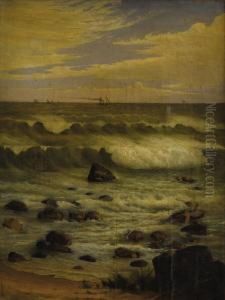Joseph Tubby Paintings
Joseph Tubby was an American landscape painter associated with the Hudson River School, a mid-19th century American art movement embodied by a group of landscape painters whose aesthetic vision was influenced by romanticism. Born in 1821 in Kingston, New York, Tubby's early life and training are not well-documented, which is common for many artists of the period. However, it is known that he was active as an artist primarily in the Rondout area near Kingston, along the Hudson River.
Tubby's landscapes often feature the serene and pastoral settings of the Hudson Valley and the Catskill Mountains, capturing the majestic beauty of the American landscape with an emphasis on natural light and atmospheric effects. His style was typical of the Hudson River School, with a focus on depicting the wilderness and rural scenes in a highly detailed and realistic manner. His paintings often celebrated the American countryside while conveying a sense of the sublime, a key element of romanticism, showcasing the grandeur and power of nature.
Despite his association with the Hudson River School, Joseph Tubby never achieved the same level of fame as some of his contemporaries, such as Thomas Cole or Frederic Edwin Church. Nonetheless, he was a respected artist in his time and his works were collected by art patrons and exhibited in galleries. Tubby continued to paint throughout his life, leaving behind a legacy of work that contributes to the broader understanding of American landscape painting in the 19th century.
Joseph Tubby passed away in 1896, leaving behind a modest but meaningful body of work. His paintings are now considered important artifacts of the Hudson River School, and they can be found in various art collections and museums, offering insights into the American landscape tradition and the cultural context of the era in which he lived and worked.
